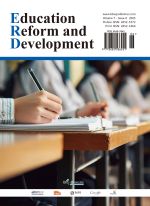Abstract
This paper explores the reform of the traditional composition major teaching model under the New Liberal Arts education concept and concludes that the reform measures such as interdisciplinary integration, application-oriented enhancement, and cultivation of innovative thinking abilities. The paper discusses two aspects: first, the teaching implications of the New Liberal Arts education concept for the traditional composition major. Second, the current situation and existing problems of the traditional composition major teaching model. Through successful teaching concept reform cases in different disciplines, it provides some feasible reform plans for the composition major teaching model reform. Then, it explores the reform effect of the traditional composition major teaching model under the New Liberal Arts perspective, examined through the cultivation of composition talents. Future research can consider the reform effects and implementation paths of other music majors under the New Liberal Arts perspective.
References
Fan F, Zhao Y, 2024, From “Liberal Arts” to “New Liberal Arts” – Analysis and Interpretation Based on Structural Functionalism. Forestry Education in China, 42(6): 1–6.
Liu J, 2024, Construction of the Talent Cultivation Model for Music Education in Higher Art Colleges from the Perspective of “New Liberal Arts”. People’s Music, 2024(6): 69–73.
Wang T, 2023, Research on the Transformation Path of the Construction of Music Education Major in Colleges and Universities from the Perspective of New Liberal Arts. Journal of Qilu Normal University, 38(6): 52–58.
Dong X, 2024, The Significance and Path of Ideological and Political Construction of Music Courses Based on the Cultivation of Applied Talents from the Perspective of New Liberal Arts. Public Relations World, 2024(24): 69–71.
Fan L, Shen S, 2024, What Can New Liberal Arts Do for the Construction of a Strong Country in Education. Journal of the National Academy of Education Administration, 2024(1): 30–37.
Huang Q, Shi M, 2024, Teaching Reform and Innovative Practice of Music Courses under the Background of New Liberal Arts and New Normal Education – Taking the Basic Music Theory Course as an Example. Art Education, 2024(5): 58–62.
Mo R, 2024, Integration of Concepts and Innovation of Methods – The Combination and Innovation of Teaching Concepts of Traditional Composition and Popular Music Composition. China Music Education, 2024(8): 35–44.
Cui Y, Lin X, Duan Y, 2024, Research on the Practical Model of Cultivating Compound Talents under the Background of New Liberal Arts. Journal of the National Academy of Education Administration (Educational Science Edition), 2024(1): 58–66.
Xing Y, Zhou Y, 2023, Construction and Practice of the Interdisciplinary Integration Teaching System of Electronic Music Major under the Background of New Liberal Arts Construction. Education Teaching Forum, 2023(41): 113–116.
Liang W, 2024, A Comparative Study of Artificial Intelligence Composition and Traditional Composition Enabled by Technology. Sichuan Opera, 2024(2): 134–137.
Feng H, 2024, Construction of the Integrated and Immersion Education Model for Music Academies in Universities under the Context of New Liberal Arts. Journal of Quanzhou Normal University, 42(3): 94–98.
Wang L, 2024, Research on the Diversified Talent Cultivation of Music Education Major from the Perspective of New Liberal Arts – Taking Comprehensive Art Colleges as an Example. Home of Drama, 2024(18): 190–192.
Yan M, Lei Y, 2024, Breakthrough and Reconstruction: The Value Logic and Methodological Principles of the Construction of New Liberal Arts. Journal of Shanghai Jiao Tong University (Philosophy and Social Sciences Edition), 32(1): 5–12.
Hu X, Chen H, 2024, Comprehensive Reform Practice of Undergraduate Teaching of Psychology under the Background of New Liberal Arts. Education Research and Development, 3(5): 104–112.
Li L, Sun N, 2024, Innovation of the Talent Cultivation System for Liberal Arts in Universities under the Background of New Liberal Arts Construction. Heilongjiang Higher Education Research, 2024(11): 52–57.
